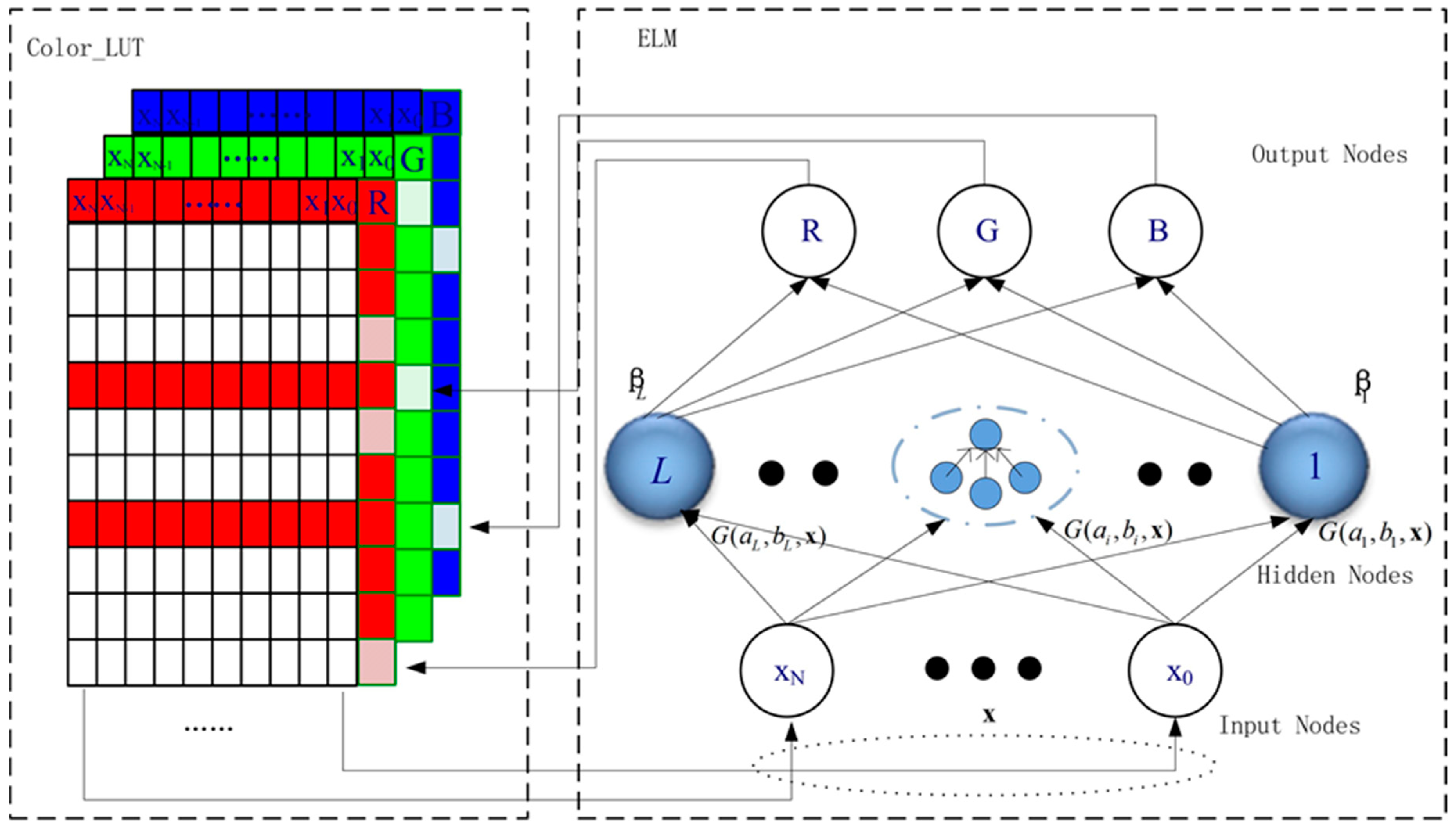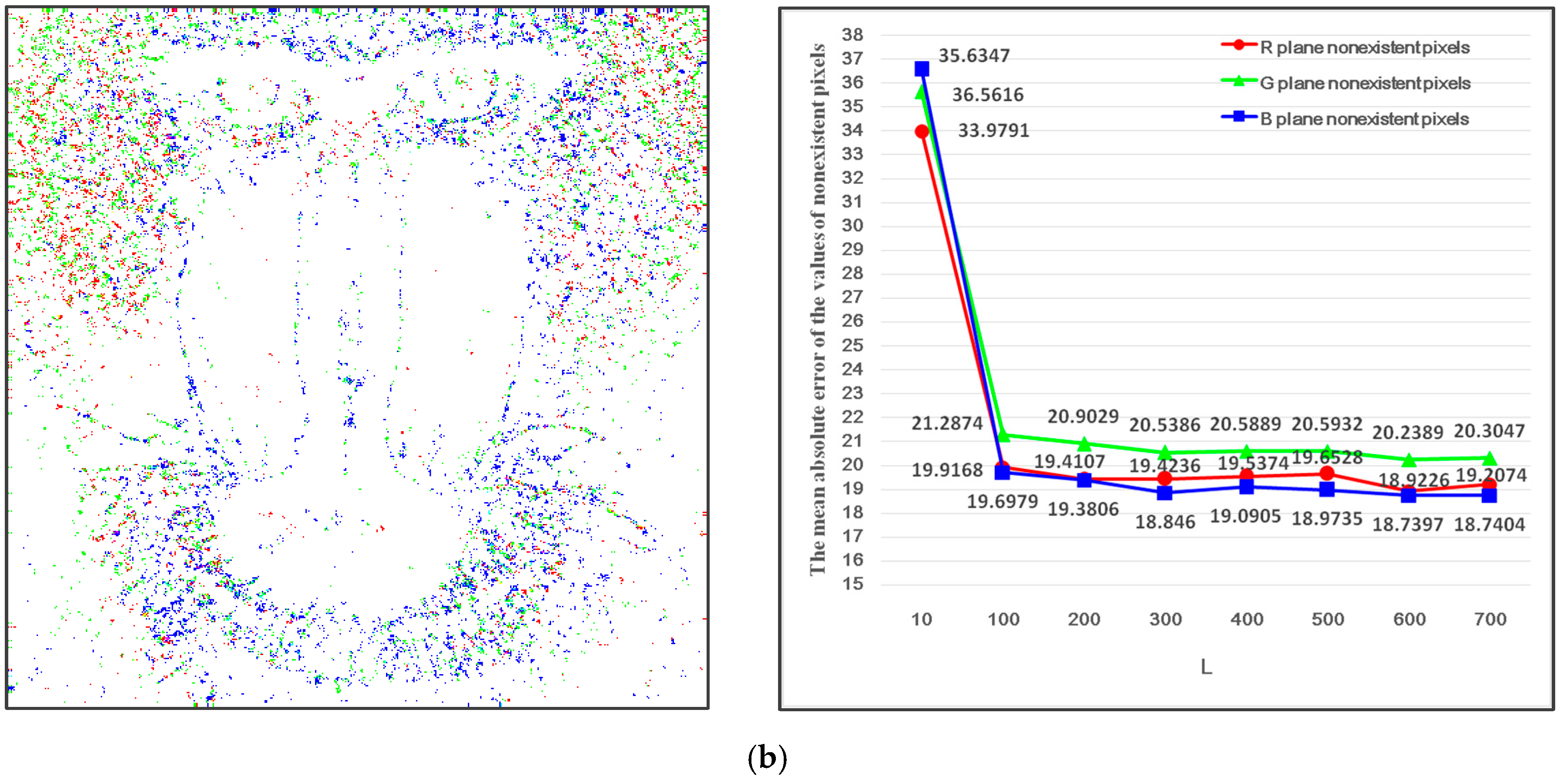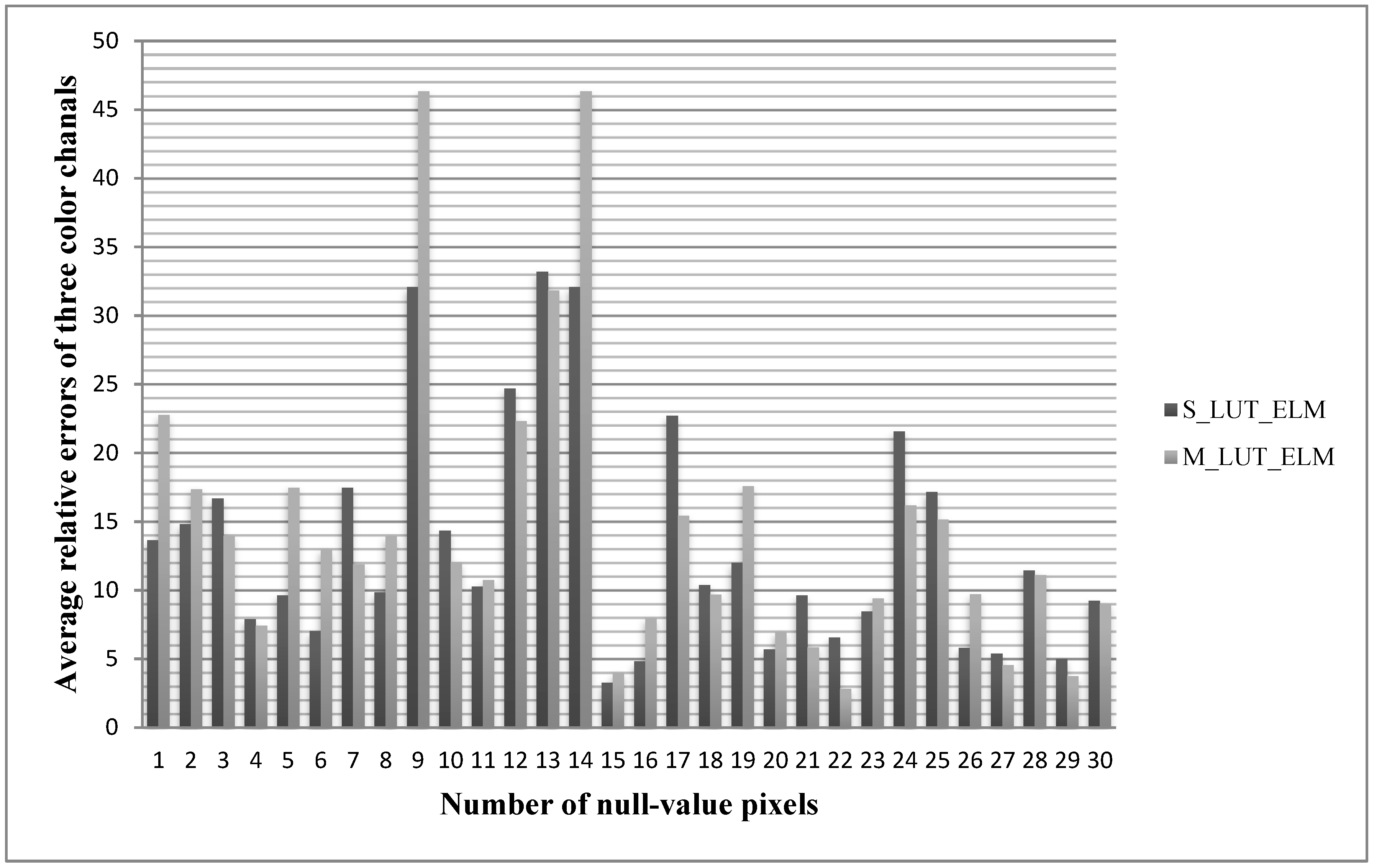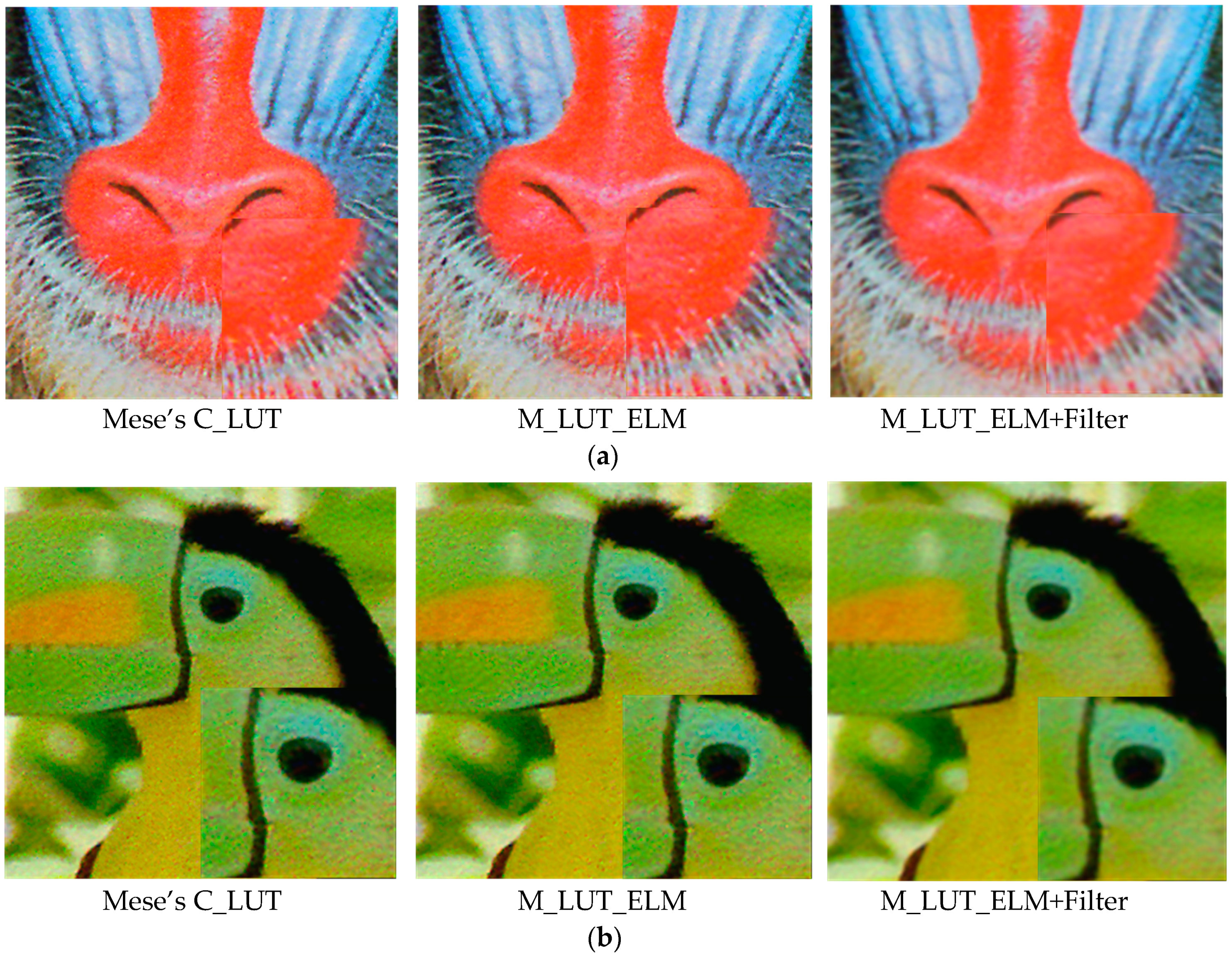Color Inverse Halftoning Method with the Correlation of Multi-Color Components Based on Extreme Learning Machine
Abstract
1. Introduction
2. Overview of the Proposed Method
3. Methodology
3.1. Design of the Initial LUT
3.2. Estimation of Nonexistent Values Based on Common Patterns and ELM
4. Experimental Results
4.1. Parameters Selection for ELM
4.2. Analysis of the Estimated Values
4.3. Comparison with State-of-the-Art Methods
5. Conclusions
Author Contributions
Funding
Conflicts of Interest
References
- Zhang, Y.; Zhang, E.; Chen, W.; Chen, Y.; Duan, J. Sparsity-based inverse halftoning via semi-coupled multi-dictionary learning and structural clustering. Eng. Appl. Artif. Intell. 2018, 72, 43–53. [Google Scholar] [CrossRef]
- Zhang, Y.; Zhang, E.; Chen, W. Deep neural network for halftone Image classification based on sparse auto-encoder. Eng. Appl. Artif. Intell. 2016, 50, 245–255. [Google Scholar] [CrossRef]
- Damera-Venkata, N.; Kite, T.; Evans, B. Fast Blind Inverse Halftoning. In Proceedings of the IEEE International Conference Image Processing, Chicago, IL, USA, 4–7 October 1998; pp. 64–68. [Google Scholar]
- Chen, L.; Hang, H. An adaptive inverse halftoning algorithm. IEEE Trans. Image Process. 1997, 6, 1202–1209. [Google Scholar] [CrossRef] [PubMed]
- Ong, Q.; Cai, J.; Gao, J. Inverse halftoning based on edge classifications and adaptive filters. Int. J. Electr. Eng. 2017, 24, 81–91. [Google Scholar]
- Luo, J.; Queiroz, R.; Fan, Z. A robust technique for image descreening based on the wavelet transform. IEEE Trans. Signal Process. 1998, 46, 1179–1184. [Google Scholar]
- Kite, T.; Damera-Venkata, N.; Evans, B.; Bovik, A.C. A fast high-quality inverse halftoning algorithm for error diffused halftones. IEEE Trans. Image Process. 2000, 9, 1583–1592. [Google Scholar] [CrossRef] [PubMed]
- Lai, J.; Yen, J. Inverse error-diffusion using classified vector quantization. IEEE Trans. Image Process. 1998, 7, 1753–1758. [Google Scholar] [CrossRef] [PubMed]
- Huang, W.; Su, A.; Kuo, Y. Neural network based method for image halftoning and inversehalftoning. Expert Syst. Appl. 2008, 34, 2491–2501. [Google Scholar] [CrossRef]
- Pelcastre, F.; Miyatake, M.; Toscano, K.; Sanchez, G.P.; Perez, H.M. An inverse halftoning algorithms based on neural networks and atomic functions. IEEE Lat. Am.Trans. 2017, 15, 488–495. [Google Scholar] [CrossRef]
- Son, C.; Choo, H. Local learned dictionaries optimized to edge orientation for inverse halftoning. IEEE Trans. Image Process. 2014, 23, 2542–2556. [Google Scholar] [PubMed]
- Son, C.; Park, H. Sparsity-based inverse halftoning. Electron. Lett. 2012, 48, 832–834. [Google Scholar] [CrossRef]
- Mese, M.; Vaidyanathan, P. Look-up table (LUT) method for inverse halftoning. IEEE Trans. Image Process. 2001, 10, 1566–1578. [Google Scholar] [CrossRef] [PubMed]
- Mese, M.; Vaidyanathan, P. Template Selection for LUT Inverse Halftoning and Application to Color Halftones. In Proceedings of the IEEE International Conference on Acoustics, Speech and Signal Processing, Istanbul, Turkey, 5–9 June 2000; pp. 2290–2293. [Google Scholar]
- Wen, Z.; Lu, Y.; Zeng, Z.; Zhu, W.-Q.; Ai, J.-H. Optimizing template for lookup-table inverse halftoning using elitist genetic algorithm. IEEE Signal Process. Lett. 2015, 22, 71–75. [Google Scholar] [CrossRef]
- Mese, M.; Vaidyanathan, P. Tree-structured method for LUT inverse halftoning and for image halftoning. IEEE Trans. Image Process. 2002, 11, 644–654. [Google Scholar] [CrossRef] [PubMed]
- Liaghat, A.; Rassaei, F. A Novel Algorithm for Inverse Halftoning Using LUT Approach and Pattern Labeling. In Proceedings of the IEEE Business, Engineering and Industrial Applications Colloquium, Kuala Lumpur, Malaysia, 7–8 April 2012; pp. 167–171. [Google Scholar]
- Kitamura, M.; Ono, F. Inverse Halftoning Method of Error Diffused Images Using Look-Up Table with State Reduction. In Proceedings of the Sixth IEEE International Symposium on Signal Processing and Information Technology, Vancouver, BC, Canada, 27–30 August 2006; pp. 890–895. [Google Scholar]
- Siddiqi, U.; Sait, S. Algorithm for Parallel Inverse Halftoning Using Partitioning of Look-Up Table (LUT). In Proceedings of the IEEE International Symposium on Circuits and Systems, Seattle, WA, USA, 18–21 May 2008; pp. 3554–3557. [Google Scholar]
- Chang, C.; Chan, C. An inverse halftoning technique using modified look-up tables. Fundamenta Informaticae 2005, 68, 207–220. [Google Scholar]
- Huang, Y.; Chung, K.; Dai, B. Improved inverse halftoning using vector and texture-lookup table-based learning approach. Exp. Syst. Appl. 2011, 38, 15573–15581. [Google Scholar] [CrossRef]
- Chung, K.; Wu, S. Inverse halftoning algorithm using edge-based lookup table approach. IEEE Trans. Image Process. 2005, 14, 1583–1587. [Google Scholar] [CrossRef] [PubMed]
- Huang, G.B.; Babri, H.A. Upper bounds on the number of hidden neurons in feedforward networks with arbitrary bounded nonlinear activation functions. IEEE Trans. Neural Netw. 1998, 9, 224–229. [Google Scholar] [CrossRef] [PubMed]
- Zhang, E.H.; Ma, H.B.; Luo, B.; Duan, J.-h. An Improved Descreening Algorithm for Color Halftone Image Based on Wavelet Decomposition. In Proceedings of the 2008 Congress on Image and Signal Processing, Sanya, China, 27–30 May 2018; pp. 242–246. [Google Scholar]








| R_LUT | G_LUT | B_LUT | |
|---|---|---|---|
| Number of existing pattern | 316,579 | 353,271 | 330,563 |
| Number of nonexistent pattern | 207,709 | 156,413 | 173,886 |
| Percent of nonexistent pattern (%) | 39.62 | 32.62 | 36.95 |
| Number of Null-Value | Actual Value | B_LIN_EST | S_LUT_ELM | M_LUT_ELM | |||
|---|---|---|---|---|---|---|---|
| Estimated Value | Relative Error (%) | Estimated Value | Relative Error (%) | Estimated Value | Relative Error (%) | ||
| 1 | 76 | 62.26 | 18.07 | 75.53 | 0.62 | 54.09 | 28.83 |
| 2 | 103 | 81.70 | 20.68 | 91.68 | 10.99 | 84.16 | 18.29 |
| 3 | 94 | 113.60 | 20.85 | 123.34 | 31.21 | 109.22 | 16.19 |
| 4 | 206 | 188.26 | 8.61 | 190.86 | 7.35 | 187.32 | 9.07 |
| 5 | 98 | 103.59 | 5.70 | 101.27 | 3.34 | 103.83 | 5.95 |
| 6 | 131 | 131.99 | 0.75 | 133.90 | 2.21 | 132.78 | 1.36 |
| 7 | 144 | 100.26 | 30.38 | 111.10 | 22.84 | 98.92 | 31.30 |
| 8 | 131 | 127.97 | 2.31 | 136.58 | 4.26 | 132.80 | 1.37 |
| 9 | 107 | 104.15 | 2.66 | 105.38 | 1.52 | 110.15 | 2.95 |
| 10 | 122 | 129.06 | 5.79 | 127.16 | 4.23 | 123.22 | 1.00 |
| 11 | 175 | 195.43 | 11.67 | 188.31 | 7.60 | 187.59 | 7.20 |
| 12 | 89 | 103.07 | 15.81 | 109.61 | 23.15 | 113.90 | 27.98 |
| 13 | 134 | 149.58 | 11.62 | 156.08 | 16.48 | 146.98 | 9.68 |
| 14 | 107 | 104.15 | 2.66 | 105.38 | 1.52 | 110.15 | 2.95 |
| 15 | 100 | 91.29 | 8.71 | 98.52 | 1.48 | 105.36 | 5.36 |
| 16 | 194 | 199.83 | 3.00 | 191.48 | 1.30 | 199.50 | 2.83 |
| 17 | 161 | 164.86 | 2.40 | 159.37 | 1.01 | 162.47 | 0.91 |
| 18 | 175 | 183.54 | 4.88 | 172.47 | 1.44 | 180.01 | 2.86 |
| 19 | 78 | 90.65 | 16.22 | 91.92 | 17.85 | 99.72 | 27.84 |
| 20 | 165 | 188.58 | 14.29 | 176.90 | 7.21 | 183.72 | 11.34 |
| 21 | 134 | 132.44 | 1.17 | 132.48 | 1.13 | 131.08 | 2.18 |
| 22 | 170 | 173.26 | 1.92 | 162.64 | 4.33 | 172.79 | 1.64 |
| 23 | 159 | 161.57 | 1.62 | 154.45 | 2.86 | 157.64 | 0.86 |
| 24 | 129 | 157.42 | 22.03 | 155.17 | 20.29 | 148.34 | 14.99 |
| 25 | 105 | 97.60 | 7.05 | 104.94 | 0.06 | 102.37 | 2.50 |
| 26 | 118 | 124.98 | 5.92 | 121.10 | 2.63 | 125.65 | 6.48 |
| 27 | 190 | 175.83 | 7.46 | 168.21 | 11.47 | 175.92 | 7.41 |
| 28 | 92 | 74.38 | 19.15 | 74.94 | 18.54 | 80.84 | 12.13 |
| 29 | 189 | 190.85 | 0.98 | 188.28 | 0.38 | 190.92 | 1.02 |
| 30 | 211 | 206.24 | 2.26 | 200.93 | 4.77 | 206.43 | 2.17 |
| Method | Wavelet Method [24] | Mese’s C_LUT | M_LUT_ELM | M_LUT_ELM+Filter |
|---|---|---|---|---|
| Airplane | 25.47/0.68 | 26.16/0.71 | 26.40/0.72 | 27.75/0.84 |
| Anhinga | 23.15/0.62 | 25.21/0.65 | 25.38/0.65 | 25.57/0.72 |
| Baboon | 21.30/0.59 | 22.04/0.62 | 22.26/0.72 | 21.93/0.57 |
| Bardowl | 24.35/0.65 | 25.61/0.69 | 25.76/0.70 | 26.16/0.71 |
| Bluheron | 26.12/0.64 | 28.23/0.65 | 28.28/0.65 | 29.67/0.76 |
| Bobcat | 26.23/0.62 | 27.35/0.67 | 27.45/0.67 | 28.29/0.74 |
| Lena | 25.87/0.60 | 27.32/0.61 | 27.92/0.64 | 28.75/0.76 |
| Parrot | 25.64/0.52 | 27.32/0.46 | 27.98/0.50 | 28.63/0.60 |
| Peppers | 24.38/0.51 | 25.18/0.54 | 25.82/0.59 | 27.28/0.70 |
| Sailboat | 23.89/0.56 | 25.22/0.65 | 25.44/0.66 | 26.11/0.72 |
| Average | 24.64/0.60 | 25.96/0.63 | 26.27/0.64 | 27.01/0.71 |
© 2019 by the authors. Licensee MDPI, Basel, Switzerland. This article is an open access article distributed under the terms and conditions of the Creative Commons Attribution (CC BY) license (http://creativecommons.org/licenses/by/4.0/).
Share and Cite
Zhang, E.; Zhang, Y.; Duan, J. Color Inverse Halftoning Method with the Correlation of Multi-Color Components Based on Extreme Learning Machine. Appl. Sci. 2019, 9, 841. https://doi.org/10.3390/app9050841
Zhang E, Zhang Y, Duan J. Color Inverse Halftoning Method with the Correlation of Multi-Color Components Based on Extreme Learning Machine. Applied Sciences. 2019; 9(5):841. https://doi.org/10.3390/app9050841
Chicago/Turabian StyleZhang, Erhu, Yan Zhang, and Jinghong Duan. 2019. "Color Inverse Halftoning Method with the Correlation of Multi-Color Components Based on Extreme Learning Machine" Applied Sciences 9, no. 5: 841. https://doi.org/10.3390/app9050841
APA StyleZhang, E., Zhang, Y., & Duan, J. (2019). Color Inverse Halftoning Method with the Correlation of Multi-Color Components Based on Extreme Learning Machine. Applied Sciences, 9(5), 841. https://doi.org/10.3390/app9050841




